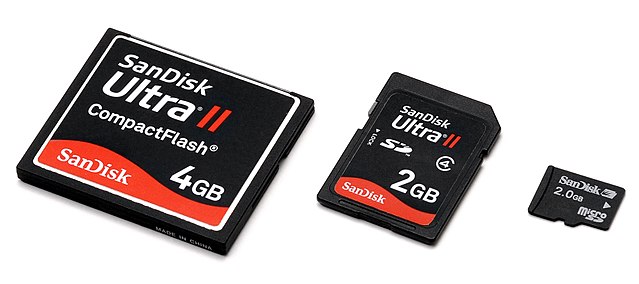Memory card
From Wikipedia, the free encyclopedia
Remove ads
Memory card ama (Kaarka xasuusta), kaydiye, waa kaar elektroonic ah qalabka kaydinta maclumatka waxana loo isticmala kaydinta waxyabaha digtalka ah. badana waxa lagu isticmala qalabyo kala duwan oo ay ku jiraan digital camera(humaag tireed), mobileda gacanta, kumbuyatarka gacanta iyo MP3 players, aad ayeey u yaryar yiin waxayna awoodan in ay maclumatka hayaan bile koronto .

Remove ads
taariikhda oo kombulet ah
PC Cards (PCMCIA)waxa ahaa nocyadi ugu hereyay ee kaydisha (qaab card ahaneed) waxanu soo baxay 1990s,laakin hadda badanaa waxa lagu isticmala shirkadaha application ah si ay ula xiriraan qalabka ah I/O sidaa modems. 1990s,tiro kaydiyal ah oo ka yaryar PC Card soo baxay, ay ku jiraan CompactFlash, SmartMedia, iyo Miniature Card.
shirkadaha aadka u hormaryay kaydisha ayaa waxa ugu cadcad shirkada sony
Since 2010 new products of Sony (previously only using Memory Stick) and Olympus (previously only using XD-Card) are offered with an additional SD-Card slot.[1] Effectively the format war has turned in SD-Card's favor.[2][3][4]
Remove ads
Data table of selected memory card formats
- Secure Digital card (SD)
- MiniSD Card
- CompactFlash (CF-I)
- Memory Stick
- MultiMediaCard (MMC)
- SmartMedia
- xD-Picture Card (xD)
Remove ads
Overview of all memory card types
Maqaal dhamaystiran: Comparison of memory cards
- PCMCIA ATA Type I Flash Memory Card (PC Card ATA Type I)
- PCMCIA Type II, Type III cards
- CompactFlash Card (Type I), CompactFlash High-Speed
- CompactFlash Type II, CF+(CF2.0), CF3.0
- Microdrive
- MiniCard (Miniature Card) (max 64 MB (64 MiB))
- SmartMedia Card (SSFDC) (max 128 MB) (3.3 V,5 V)
- xD-Picture Card, xD-Picture Card Type M
- Memory Stick, MagicGate Memory Stick (max 128 MB); Memory Stick Select, MagicGate Memory Stick Select ("Select" means: 2x128 MB with A/B switch)
- SecureMMC
- Secure Digital (SD Card), Secure Digital High-Speed, Secure Digital Plus/Xtra/etc (SD with USB connector)
- miniSD card
- microSD card (aka Transflash, T-Flash)
- SDHC
- MU-Flash (Mu-Card) (Mu-Card Alliance of OMIA)
- C-Flash
- SIM card (Subscriber Identity Module)
- Smart card (ISO/IEC 7810, ISO/IEC 7816 card standards, etc.)
- UFC (USB FlashCard) Archived Febraayo 24, 2006 // Wayback Machine (uses USB)
- FISH Universal Transportable Memory Card Standard (uses USB)
- Disk memory cards:
- Clik! (PocketZip), (40 MB PocketZip)
- Floppy disk (32MB, LS120 and LS240, 2-inch, 3.5-inch, etc.)
- Intelligent Stick (iStick, a USB-based flash memory card with MMS)
- SxS (S-by-S) memory card, a new memory card specification developed by Sandisk and Sony. SxS complies to the ExpressCard industry standard.
- Nexflash Winbond Archived Oktoobar 13, 2007 // Wayback Machine Serial Flash Module (SFM) cards, size range 1 mb, 2 mb and 4 mb.
Video game consoles

Video game consoles use memory cards to hold saved game data. Cartridge-based systems primarily used battery-backed RAM within each individual cartridge to hold saves for that game. The Neo Geo AES, released in 1990 by SNK, was the first video game console able to use a memory card. AES memory cards were also compatible with Neo-Geo MVS arcade cabinets, allowing players to migrate saves between home and arcade systems and vice versa. Memory cards became commonplace when home consoles moved to read-only optical discs for storing the game program, beginning with systems such as the TurboGrafx-CD and Mega-CD.
Until the sixth generation of video game consoles, memory cards were based on proprietary formats; later systems have used established industry hardware formats for memory cards.
Home consoles now commonly use hard disk drive storage for saved games. though most portable gaming systems still rely on custom memory cartridges to store program data, due to their low power consumption, smaller physical size and reduced mechanical complexity.
Remove ads
See also
- Hot swapping
References
Wikiwand - on
Seamless Wikipedia browsing. On steroids.
Remove ads







